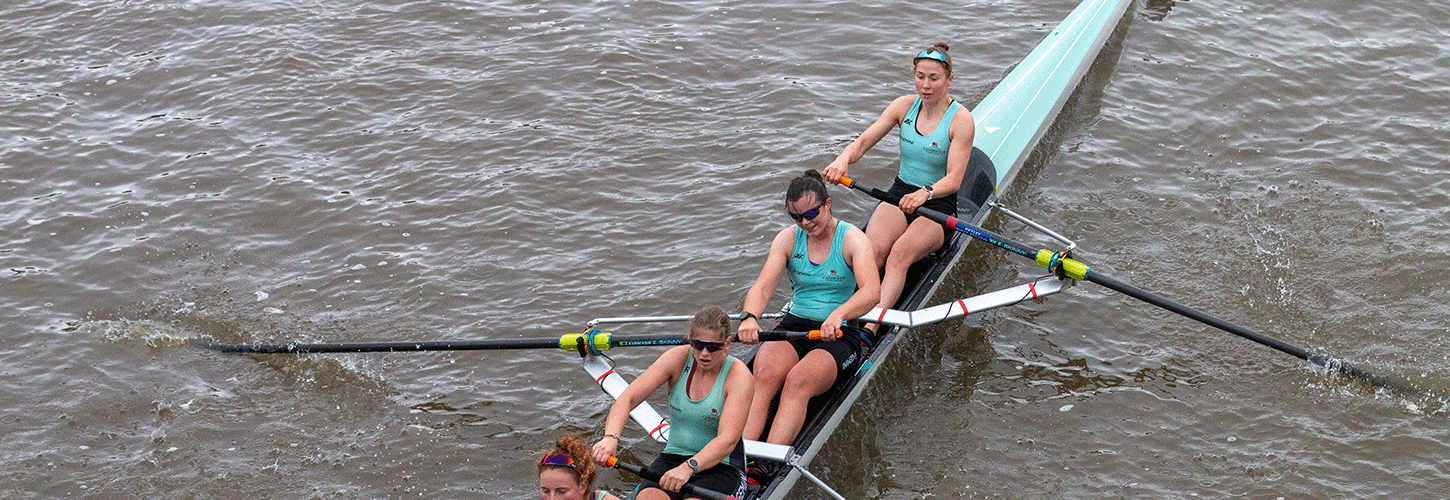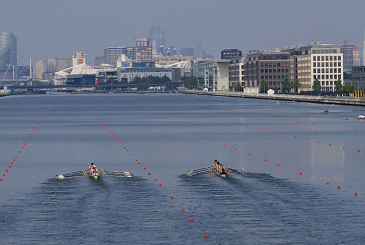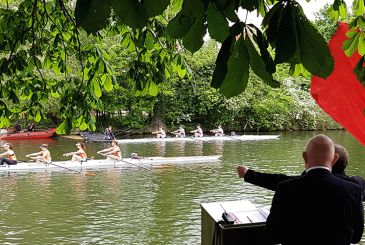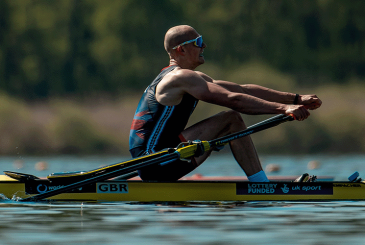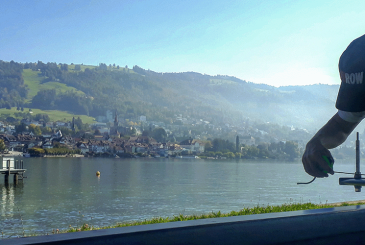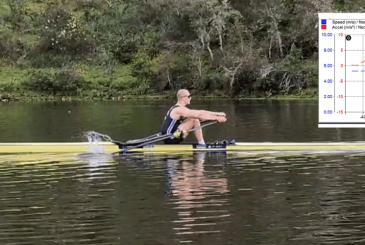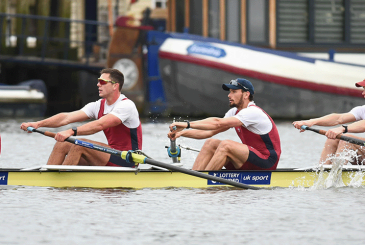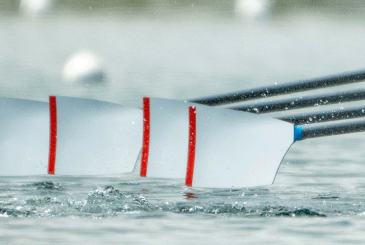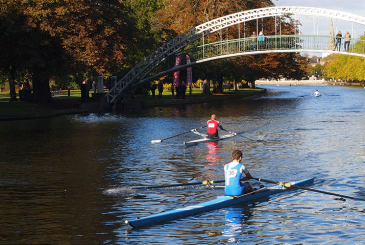Alex McMullen from Junior Rowing News outlines practical advice and top tips from five athletes who have done this successfully.
When it comes to events like the Fours Head, those with the added responsibility of foot-steering have been known to feel the pressure. Luckily, with the contribution of experienced, successful steers, this piece provides a handy guide to master the art of foot-steering the formidable Tideway.
Tip1: Learn your lines
Rules are in place for a reason. Even for experienced steers like Gemma King, who captained the England Rowing Team at the 2023 Home International Regatta, the essential component of pre-race prep is to read the rules.
“I always make sure I look at the race rules and check where we are supposed to marshal before the race,” says King. “Having raced on the Tideway many times for Cambridge University and Lady Eleanor Holles School, I am aware of most of the rules, but it is always worth checking in case something has changed!”
“Studying the course map and understanding the streams beforehand was critical”
This ethos is even more important for those who do not have the local advantage of training on the Tideway prior to race day. Jim Gleed of Newark RC knows this all too well. “My experience of head racing on a similar scale before my first Fours Head was limited to the Head of the Trent and Yorkshire Head of the River,” says Gleed. “Steering the Tideway is a pretty different beast, so studying the course map and understanding the streams beforehand was critical.”
Ben, a junior athlete at King’s College School, Wimbledon, emphasises this cardinal rule more still. “Although I’ve steered upwards of 200 times on the Tideway, my pre-head race approach is always looking at depth charts, reminding myself where the deepest water is, watching the ‘Steering the Tideway’ video and, finally, reminding myself where I need to be as we paddle up past certain places.”
Tip 2: Seek advice
River knowledge should never be overlooked, and that’s particularly true of the Tideway. University of London’s Georgie Robinson-Ranger has had significant success steering at the likes of Fours Head and Pairs Head, and she attributes much of this success to the people who prepared her to such a degree that there was little room for error.
“There is a ‘racing line’ of faster water, and most coaches will have a good idea of where that is or will know someone that does. I’d recommend running over it with them pre-race to gain as many crucial seconds as possible,” says Robinson-Ranger.
In addition to speaking to coaches, Anna Smart of Thames RC also recommends relying on teammates or athletes from other clubs for extra nuggets of advice ahead of race day. Smart highlights, “Since we [at Thames RC] train on the Tideway, we also have the advantage of practising lines ahead of racing, but I always make sure to speak to friends who’ve also been in my [steering] shoes many times before, to reassure myself that I’m applying the correct principles.”
Tip 3: “Marshals and landmarks are your best friend”
Smart could not state the importance of key markers on the course enough. “Overall, you want to stick to the middle of the river, and you can use the bridges for guidance,” she adds.
Smart highlighted some handy markers for Tideway head newbies, too. “Go through Barnes Bridge slightly diagonally, from Surrey to Middlesex. Going through Hammersmith Bridge, you should aim you bows for the second lamppost from the Surrey. There are also lots of useful guides online to walk you through all of the steering markers if you need to visualise it and you don’t have the benefit of training on the course.”
Stay slightly to stroke side of the centre for the first half
Robinson-Ranger agrees, “The marshals will help you out if things get a bit awry with steering.” As the Tideway is more a series of long bends than perfect straights, a good general rule to stay in the faster water is to stay slightly to stroke side of the centre for the first half, and slightly to bow side of the centre for the second half.
Tip 4: Make your overtaking position clear
Overtaking is by no means an easy feat on the Tideway. “Sticking to your chosen line means you’re more predictable for the crew you’re overtaking. Zigzagging makes it difficult for them to decide which way to go,” advises Robinson-Ranger.
However, you may still find yourself pushed all the way over to the bank and out of the fast stream, or worse, clashing with a buoy that will cost you seconds while trying to gain on the crew in front. To mitigate this risk, it’s essential that you look round often enough. “It varies a bit, but I’d say typically look around every 5 to 10 strokes,” highlights King. “I definitely look round more when approaching bridges, especially Barnes Bridge as it is a narrower gap to pass through and is around a bend. I also look round more if I know that there are crews that we are gaining on or need to be aware of.”
Aim to overtake to Middlesex in the first half
Ben hammers home the fact that the rules of overtaking must be respected at all times. “If my crew is potentially catching others, I will start to look around more frequently, to work out where I need to be relative to the opposition to overtake safely.” For simple overtaking situations, aim to overtake to Middlesex in the first half and Surrey in the second.
Ben reflects on the challenges of overtaking, too. “Knowing where to be at what point of the course, being able to account for the tide when steering, turning or just training, and knowing how to limit the effect of other traffic’s wash on the boat can be tricky.”
Tip 5: Just keep practising!
The final tip here is an age-old adage, but one that rings true: practice makes perfect. “Your best bet with training is to practise taking bends at speed at your home club, which makes a bendy stretch ideal for best practise,” Gleed advises. “Otherwise, it can be quite daunting to be confronted which a river of such vastness, especially if you have never steered on water with major bends before.”
Small foot movements make for big gains in foot steering. All the athletes concurred that with as much practice as possible, things will come together on the day.
“On the Tideway the stream is very fast and generally will take the boat with it so minimal steering is needed,” says King. “The rudder also acts as a brake so the less you can use it the better!”
Robinson-Ranger also summed up the importance of repetition perfectly, “As with all skills in rowing, practice makes a big difference and steering experience in training and other races is so valuable to building up confidence when you finally get out there on race day.”
Photo: Ed Evans.


